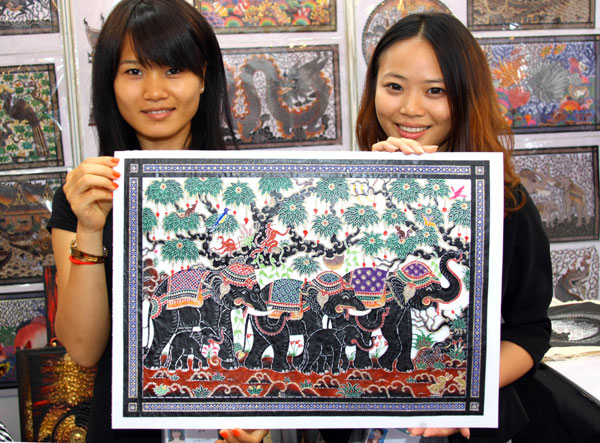Economists hailed the achievements of the cooperation between China and members of the Association of Southeast Asian Nations, while urging ASEAN countries to upgrade industries, enhance trade and investment, and establish a free labor market to further boost development.
 |
|
Two staff members of the Thailand pavilion show an artifact made of cowhide to visitors on Friday at the Ninth China-ASEAN Expo. [Photo/China Daily] |
Gu Shengzu, economist and vice-chairman of the Committee for Internal and Judicial Affairs of the National People's Congress, said on Friday at the 2012 Forum on the China-ASEAN free trade area, that ASEAN countries, including many emerging economies, are facing competition with each other.
Therefore, it's crucial to address the issue of industry distribution to avoid unnecessary competition in low-end production sectors, and to achieve industry upgrades, he said.
He also emphasized the importance of enhancing the legal and investment environment within ASEAN.
Li Guanghui, vice-president of the Chinese Academy of International Trade and Economic Cooperation, said that China-ASEAN cooperation will likely see rapid development in investment, services trade, and in high-tech and advanced manufacturing.
Wang Yijiang, a professor at the University of Minnesota, said that China-ASEAN cooperation has a bright future, despite the lackluster global economy and the slowdown of the Chinese economy.
He said that trade between China and ASEAN member countries, which are less affected by the global financial crisis, will play a large role in stimulating the Chinese economy.
He proposed the creation of a special talent zone to achieve win-win cooperation between China and the organization. The professor suggested the creation of a free labor market in the Beibu Gulf region to attract workers from ASEAN - one of the area's richest resources.
The organization should use its labor advantage to promote investment, manufacturing, business and trade, and to inject vitality to the economic development of the ASEAN-China Free Trade Area, Wang said.
James Mirrlees, a Nobel laureate in economics, echoed that view, saying that the establishment of a common labor market for freer migration is needed.
Speaking at the forum, Mirrlees said that the China-ASEAN free trade area should learn from the experience of the European Union.
Mirrlees said that he believes that both China and ASEAN members will continue to see growth, but not as fast as expected.
With a population of 1.9 billion, the China-ASEAN free trade area is the world's first FTA established among developing countries and the world's third-largest such area in terms of trade volume, after the North American and European free trade areas.
Under the FTA framework, China and six ASEAN nations - Brunei, the Philippines, Indonesia, Malaysia, Thailand and Singapore - will cut to zero the tariff on 90 percent of imported goods, or about 7,000 product categories. The other four ASEAN members will follow suit beginning in 2015.
After the establishment of the China-ASEAN free trade area on January 1, 2010, bilateral trade between China and ASEAN members rose to $136.5 billion in the first half of 2010, an increase of 55 percent year-on-year.
Huang Feifei and Huo Yan contributed to this story.
wangzhuoqiong@chinadaily.com.cn